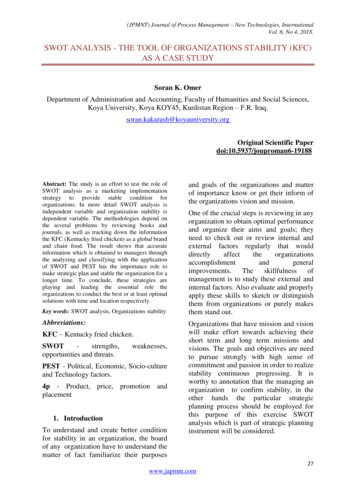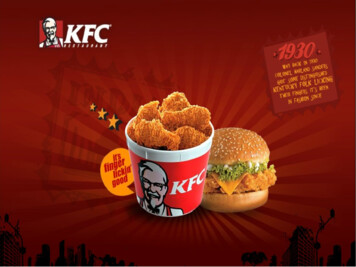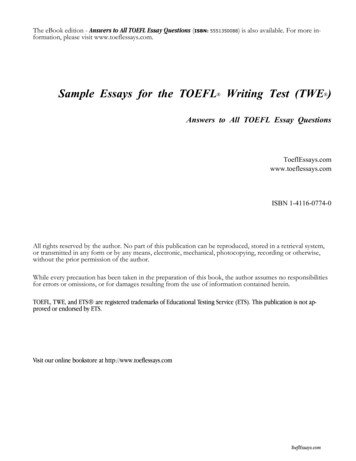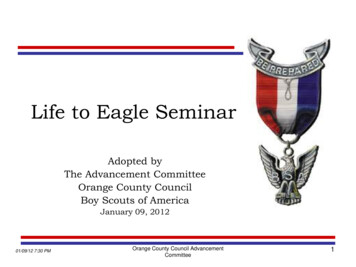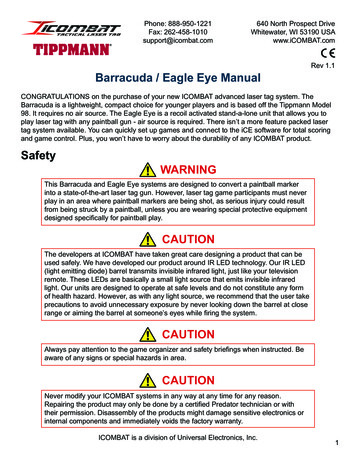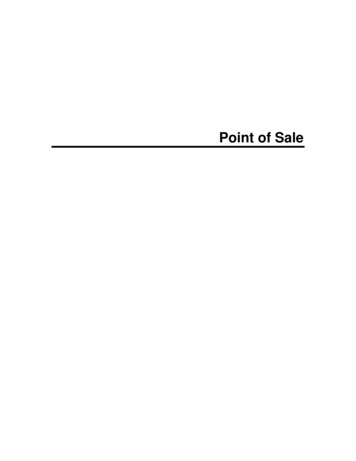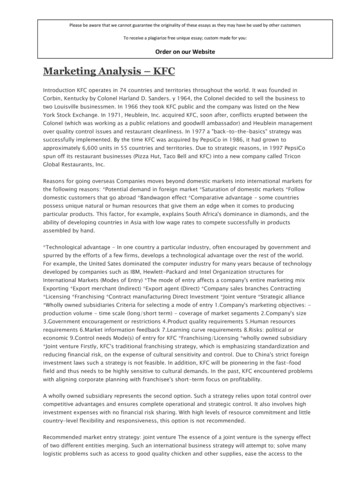
Transcription
Please be aware that we cannot guarantee the originality of these essays as they may have be used by other customersTo receive a plagiarize free unique essay; custom made for you:Order on our WebsiteMarketing Analysis – KFCIntroduction KFC operates in 74 countries and territories throughout the world. It was founded inCorbin, Kentucky by Colonel Harland D. Sanders. y 1964, the Colonel decided to sell the business totwo Louisville businessmen. In 1966 they took KFC public and the company was listed on the NewYork Stock Exchange. In 1971, Heublein, Inc. acquired KFC, soon after, conflicts erupted between theColonel (which was working as a public relations and goodwill ambassador) and Heublein managementover quality control issues and restaurant cleanliness. In 1977 a "back-to-the-basics" strategy wassuccessfully implemented. By the time KFC was acquired by PepsiCo in 1986, it had grown toapproximately 6,600 units in 55 countries and territories. Due to strategic reasons, in 1997 PepsiCospun off its restaurant businesses (Pizza Hut, Taco Bell and KFC) into a new company called TriconGlobal Restaurants, Inc.Reasons for going overseas Companies moves beyond domestic markets into international markets forthe following reasons: *Potential demand in foreign market *Saturation of domestic markets *Followdomestic customers that go abroad *Bandwagon effect *Comparative advantage - some countriespossess unique natural or human resources that give them an edge when it comes to producingparticular products. This factor, for example, explains South Africa's dominance in diamonds, and theability of developing countries in Asia with low wage rates to compete successfully in productsassembled by hand.*Technological advantage - In one country a particular industry, often encouraged by government andspurred by the efforts of a few firms, develops a technological advantage over the rest of the world.For example, the United Sates dominated the computer industry for many years because of technologydeveloped by companies such as IBM, Hewlett-Packard and Intel Organization structures forInternational Markets (Modes of Entry) *The mode of entry affects a company's entire marketing mixExporting *Export merchant (Indirect) *Export agent (Direct) *Company sales branches Contracting*Licensing *Franchising *Contract manufacturing Direct Investment *Joint venture *Strategic alliance*Wholly owned subsidiaries Criteria for selecting a mode of entry 1.Company's marketing objectives: production volume - time scale (long/short term) - coverage of market segaments 2.Company's size3.Government encouragement or restrictions 4.Product quality requirements 5.Human resourcesrequirements 6.Market information feedback 7.Learning curve requirements 8.Risks: political oreconomic 9.Control needs Mode(s) of entry for KFC *Franchising/Licensing *wholly owned subsidiary*Joint venture Firstly, KFC's traditional franchising strategy, which is emphasizing standardization andreducing financial risk, on the expense of cultural sensitivity and control. Due to China's strict foreigninvestment laws such a strategy is not feasible. In addition, KFC will be pioneering in the fast-foodfield and thus needs to be highly sensitive to cultural demands. In the past, KFC encountered problemswith aligning corporate planning with franchisee's short-term focus on profitability.A wholly owned subsidiary represents the second option. Such a strategy relies upon total control overcompetitive advantages and ensures complete operational and strategic control. It also involves highinvestment expenses with no financial risk sharing. With high levels of resource commitment and littlecountry-level flexibility and responsiveness, this option is not recommended.Recommended market entry strategy: joint venture The essence of a joint venture is the synergy effectof two different entities merging. Such an international business strategy will attempt to; solve manylogistic problems such as access to good quality chicken and other supplies, ease the access to the
Chinese market, share risk with a local entity, and finally serve as a sign of commitment to the hostgovernment increasing goodwill. In addition, due to the complexity of many barriers to entry intoChina, a potential partner with sufficient contacts/networks with government agency officials maysmoothen the process of setting-up operations in the nation.The potential joint-venture partner should be large, well established, provide excellent distributionchannels and have personal network access to government officials. It should also have modernequipment and a good management record. It is recommended that a partner is found by backwardsintegration. In other words, it is a good domestic poultry supplier. In order to ensure totalcommitment and balance of power between the two partners, a 55/45 joint venture, with KFC as thedominant partner should be set-up.By building on each partner's core competencies, knowledge, and efficiencies, a mutually beneficialsynergy effect could be achieved as a result of joint venture activities. For instance, the local partnercan learn from KFC how to produce a better product at a lower cost and further expand on its newcompetitive positioning. KFC, on the other hand, can maintain quality supply which is detrimental toits success.A joint venture will also significantly ease the entry to the virgin Chinese market. A new entrant wouldfind it very difficult to form local and personal networks between businesses and governmentagencies, which are crucial to success and provide access to the local market and domestic suppliers.In addition, local business customs and laws can be quicker understood and established ways to cutbureaucratic red-tape can be further utilized. Also, the local knowledge of culture, language andgeography is beneficial for any foreign entrant into a relatively unknown market.In order to cope with the significant political risk of investing in China, a local joint venture partner willshare this risk. There is always a risk of domestication measures imposed by the host government,often leading to major financial losses for the foreign investor. By having a 55/45 joint ventureagreement, this risk is potential eliminated, since only 55 percent of operations are domesticated. Ifsuch an unfavorable situation would arise, KFC has clearly less to loose in such an agreement. Inaddition, by being the dominant partner, KFC will be able to ensure cost, quality and strategic controlmeasures.The Chinese government may very well find KFC beneficial to the nation, as it is the pioneeringwestern fast-food outlet. Training the joint venture partner, personnel and other institutions in thevalue chain can reduce learning and experience curves. KFC's operations may also inspire localcompetitors to increase service and quality of food. It can also help to create a competitive fast-foodindustry in China as new competitors respond to KFC's ideas. Moreover, a joint venture agreementcommonly produces goodwill and commitment between the host government and the foreign investor.In such a relationship, the foreign investor is not seen as trying to take advantage of the nation forprofit purposes, but rather show willingness to share. Maintaining good relations with the hostgovernment is a critical success factor as government policy impacts intensely upon businessactivities.Factors that influence marketing decisions Social and cultural forces *Family *Social customs andbehaviour *Education *Language differences Economic environment *Infrastructure *Level of economicdevelopment *Competition Political and legal forces *Trade barriers oTariff oImport quota oDumpingoLocal-content law oBoycott *Trade agreements oGATT oWTO oEU oNAFTA oAPEC oASEAN Informationgathering (Marketing Research) Marketing research - the systematic and objective identification,collection, analysis, and dissemination of information that is undertaken to improve decision making
related to identifying and solving problems (opportunities) in marketing. It is indeed, has a broadrange of applications and plays a crucial role in the marketing decision-making process.The task of marketing research is to assess the information needs and provide management withrelevant, accurate, reliable, valid, and current information to aid marketing decision marking.Company conduct and use marketing research to stay competitive and to avoid high costs associatedwith making poor decisions based on unsound information.Marketing research plays a significant part in the development of marketing plans because it allowsthe organization to become less isolated from the key trends and changes, which surround theirproduct. To continue to be successful, organizations must receive information, from the researcherthat is clear and accurate. It also has to satisfy your pre-determined goal for your research.Steps in international marketing research: 1.define research problem(s) 2.develop a research design3.determine information needs 4.collect the data (secondary and primary) 5.analyze the data andinterpret the results 6.report and present the findings of the study Major research challenges1.Complexity of research design due to environmental differences 2.lack and inaccuracy of secondarydata 3.time and cost requirements to collect primary data 4.coordination of multicounty researchefforts 5.difficulty in establishing comparability across multi-country studies Primary Research The useof: - *Focus group *Survey methods for cross-cultural marketing research - Questionnaire - Sampling(unit, size, procedure) - Contact Methods (mail, phone, personal interview, online survey) *Collectinginformation Secondary Research Use of : *Secondary data (data which is already available) *Primarydata (when information is not useful or not exist) *Secondary data sources: government, Lexis/Nexis,FINDEX, ACNielsen, etc., Problems with secondary data research: *Accuracy of data *Age of data*Reliability over time *Comparability of data - triangulate - Functional or conceptual equivalence*Lumping of data *The data may have been collected and manipulated for a specific use, therefore itmay be incomplete, ambiguous or out of context.*Data may be compiled in different ways in different countries making comparability difficult. Forexample, in Germany consumer expenditures are estimated largely on the basis of turnover taxreceipts, in the UK they are measured on tax receipts plus household surveys and production sources.Similarly with GNP measures, it only reflects average health per head of population and not how it isdispersed. As seen earlier, bimodalities are normal, thus introducing bias. GNP may be understated forpolitical reasons and may not reflect education (i.e. wealth based on minerals). Also infrastructure mayreflect channelled funds, say for tourism, rather than society as a whole - typical of many Africancountries.*Data may be corrupted by methodological and interpretive problems, for example, definitional error,sampling error, section error, non-response error, language, social organizations, trained workers,etc.*Data may be non-existent, unreliable or incomplete thus making inter country comparisons verydifficult *Data may be inflated or deflated for political purposes *Data from documented sources must,therefore, be treated with care and caution Special problems in international marketing research Aswell as the difficulties associated with secondary data described earlier, there are a number of otherproblems connected with obtaining data in the global context. These are as follows: *Multiple marketsneed to be considered each with unique characteristics, availability of data and research services*Many markets are small and do not reflect the cost of obtaining data for such a small potential*Methodological difficulties may be encountered like nuances of language, interpretation, difficulty offieldwork supervision, cheating, data analysis difficulties (lack of computer technology) *Infrastructure
difficulties - lack of telephones, roads, transport, respondent locations and, *Cultural difficulties reluctance to talk to strangers, inability to talk to women or children, legal constraints on datacollection/transmission.*Many of these facets apply more to developing than developed countries. However using a variety ofmethods, outlined in the section, a lot of them can be ingeniously overcome *Whilst the gathering ofinformation in the international context is fraught with difficulties, without it the marketer would beplanning in the dark. The two most important modes of scanning are surveillance and search, eachgiving data of a general or specific kind, invaluable to the strategy formulation process. In all decisionswhether to obtain data or not, costs versus benefits have to be considered carefully SWOT is a methodof analysis which examines a company's Strengths, Weaknesses, Opportunities and Threats. Oftenused as part of the development process for a marketing plan, or to feed the results of a marketingaudit back into a revised plan According to the analysis, there are mainly two weaknesses for KFC. Oneof them is financial problem and the other one is that KFC concentrates on only one single market. Forits strength, it has its own unique skill in fried chicken and it has established a good brand name.However, it is now facing a threat. Nowadays, people are more concerned with the healthiness in foodand their demand for high quality of food is increasing. Also, it is now under economic crisis.Nevertheless, it still has an opportunity in its market. It is because KFC is an leader in fried chickenmarket. (Fried chicken) The early entry into international markets placed KFC in a strong position tobenefit from international expansion. Most of KFC's international expansion was through franchises,due to the fact that they were owned and operated by local entrepreneurs with a deep understandingof local language, culture, c
Marketing Analysis – KFC Introduction KFC operates in 74 countries and territories throughout the world. It was founded in Corbin, Kentucky by Colonel Harland D. Sanders. y 1964, the Colonel decided to sell the business to two Louisville businessmen. In 1966 they took KFC public and the company was listed on the New York Stock Exchange. In 1971, Heublein, Inc. acquired KFC, soon after, conflicts erupted
